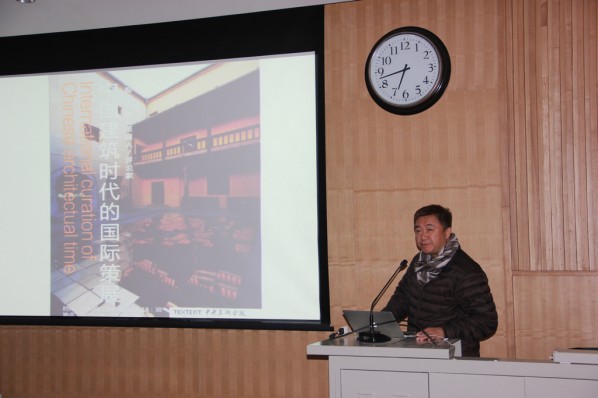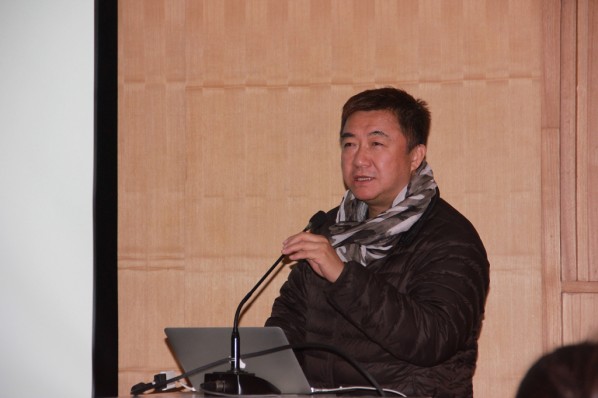
At 18:30 on December 13th, 2013, the independent international curator Fang Zhenning gave a speech on the “International Curation of Chinese Architectural Time” at the red chair auditorium on the ground floor of building 7. Fang Zhenning mainly introduced the selection of architectural exhibitions that were planned by him since 2008, and put forward the basic qualities of an independent curator.
At the beginning of the lecture, Fang Zhenning traced his own writing and curatorial history. He had been writing exhibition reviews for 31 years. From 2006; Fang served as a curator. He believed, it was necessary for curators to have a fine basis in writing, as an independent curator separate from the institute, he mainly undertook government projects. His first official architectural exhibition was “Heart-Made: The Cutting Edge of Chinese Contemporary Architecture (2009 - 2010)” which was held by CIVA in Brussels, it was once called “Vector”, but later with thinking on local culture and popular propagation, it was renamed “Heart-Made” after deliberation, which also reflected that curators should pay attention to popularity and transmissible quality, on the basis of maintaining the original concepts of the exhibition, when they thought of exhibition titles.
In addition, he also introduced the process of the design of albums, because the exhibition hall was not ideal, he focused on the design of the catalogue, striving to be specific and perfect in addition to the organization of the exhibition. It was also a good start for following exhibitions: many well-known international exhibition pavilions invited Fang Zhenning to serve as an exhibition curator after seeing the catalogue.
After that, invited by Vitra Design Museum, Fang Zhenning went to Weimar, Germany to plan “East Wind – New Chinese Architecture 2000 - 2010”, which was on display at the No.8 Buckminster Fuller Pavilion. The exhibition route was designed to be polygons, in order to coincide with the shape of the Buckminster Fuller Pavilion. The pavilion is eight meters high, and the exhibition used the space which was 40 cm above the ground, applying horizontal- stripe sunshine boards to construct booths. Different from looking up, the previous way of seeing the exhibition, he hoped that by using height and design he created a feeling that a river was gently flowing across the space, giving spectators special visual experiences to look down, aiming at “being unprecedented every time”. Subsequently, “Eastern Wind” in Liechtenstein was his second show, a Chinese architectural exhibition was initially held in the place, whereby he also appreciated the historical sense of a curator.

“Relationships – Chinese New Architecture (Museum of Art for the XXI Century, Roma, 2011)” was the third exhibition for Fang. Drawing on previous curatorial experiences, Fang Zhenning selected architectural works from different regions across the nation, including works by outstanding female architects, in order to ensure it was a broad and representative exhibition. At the same time, he used the concept of Chinese axis in the arrangement, while screens, earthen houses, etc., strongly reflected the Chinese color, designing a small door at the entrance of the exhibition, which was revised many times to ensure it was beautiful and convenient for disabled people to enter. In the arrangement of the works, he thought it was necessary to maintain the visual contacts and responding relationships between the works. He stressed “attempting to change every exhibition into an artwork”, the works of different styles not only maintained the uniqueness, but also integrated together, revealing the artistic features of the exhibition.
Fang Zhenning eventually showcased “Originaire –China Pavilion of the 13th Venice Biennale” (Venice, 2012), “Chinese Architecture – The 100 Contemporary Projects” (Mannheim Museum, 2012), “Tomorrow Landscape City” (Shanghai Himalayas Museum, 2013), “China Pavilion – Chinese Architecture Exhibition” (Segovia in Spain, 2013), etc. He emphasized that independent curators should have basic qualities including: a good writing base, a norm and flexible planning exhibition, a firm position and so on, this greatly inspired the audience on-site
Journalist: Sun Zheng/ text and photo, translated by Chen Peihua and edited by Sue/CAFA ART INFO.




























